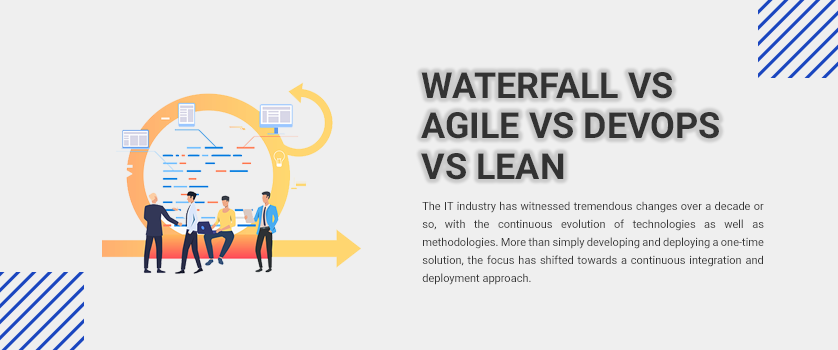


The IT industry has witnessed tremendous changes over a decade or so, with the continuous evolution of technologies as well as methodologies. More than simply developing and deploying a one-time solution, the focus has shifted towards a continuous integration and deployment approach. There is a constant need for upgrading and integrating the solution with the existing software to meet the market demands.
Therefore, owing to a continuous delivery approach, the communication between stakeholders involved in developing a software solution and the end-users has increased more than ever, due to which there is a constant need for feedback and its implementation. SDLC began with Waterfall but is gradually shifting to other models and finally approaching the agile DevOps and Lean methodologies.
This model is a traditional methodology and a first-of-its-kind software development model that follows a linear software development approach. Each phase in the waterfall model is completed before it moves on to the next phase. In the sequential type of software development, each phase is distinct and has to be very clear from the very beginning. The phases begin with requirement gathering followed by analysis, design, coding, testing, and deployment.
Due to its rigid nature of development, as one cannot go back to the previous phase to make any change, the model gradually became obsolete with the emergence of the dynamic nature of the software development process, where there needs to be a constant change in implementation, as per the user feedback, to keep up with the changing needs of the IT industry.
Let us look at the few modern software development models extensively followed in today’s industry.
The concept of lean software development derived its existence in the IT industry from Toyota manufacturing, as Toyota production system was the first company to introduce the lean development process in the mid 20th century to improve their car production and eliminate wastage of time and resources.
Many manufacturing sectors, across various industries, followed this approach, which was first implemented in software development in 2003.
There are various reasons for the popularity of Lean methodology in the IT industry, such as it allows frequent product changes and software releases, shorter development life-cycle, seamless exchange of preliminary development steps, simultaneous improvement in development quality and time, etc.
These are some of the noteworthy factors that make the lean development model crucial for organizations that want to keep up with the current pace of software development.
Agile is a continuous integration and deployment approach which is iterative in nature. It derives its principles from Lean methodology. Some of the agile approaches can be attributed to the following concepts:
Agile Process:
Following are the various processes that are used to implement agile -
Some of the scrum practices are listed as follows:
This terminology emerged from the term's development and operations respectively. DevOps emphasizes the constant collaboration and communication between the teams to ensure a seamless development process. The various phases in the DevOps life cycle are focused on constantly monitoring, operating, implementing, and responding to the end-user feedback to ensure continuous integration and deployment.
Following are the phases in the DevOps life cycle:
The DevOps life cycle focuses on efficiently bridging the gap between the tools, processes, and capabilities.
Although by now we understand the correlations and similarities between the four terminologies mentioned in the article, we have still attempted to list down these differences as well as similarities for a more comprehensive understanding.
Agile inherits its underlying meaning from Lean practices of process implementation. Therefore, there is no substantial difference between the two, as both the methodologies emphasize time-saving and cost reduction through continuous implementation, eliminating unnecessary development.
There are various methodologies and approaches for software development, however not all methodologies are used in every organization. The adoption of a strategy and technique largely depends on the type of projects a company has, the kind of audience it caters to, and various other factors that form the foundation for the selection of a certain type of methodology.